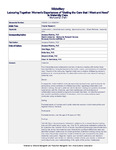Labouring Together: Women's experiences of “Getting the care that I want and need” in maternity care
| dc.contributor.author | Watkins, V | |
| dc.contributor.author | Nagle, C | |
| dc.contributor.author | Kent, B | |
| dc.contributor.author | Street, M | |
| dc.contributor.author | Hutchinson, AM | |
| dc.date.accessioned | 2022-08-04T14:01:23Z | |
| dc.date.available | 2022-08-04T14:01:23Z | |
| dc.date.issued | 2022-10 | |
| dc.identifier.issn | 0266-6138 | |
| dc.identifier.issn | 1878-1799 | |
| dc.identifier.other | 103420 | |
| dc.identifier.uri | http://hdl.handle.net/10026.1/19483 | |
| dc.description.abstract |
Poor interprofessional collaboration and lack of decision-making with women have been identified as being detrimental to the quality, safety, and experience of maternity care. The aim of the Labouring Together study was to explore childbearing women's preferences for and experiences of collaboration and control over decision-making in maternity care. Design A sequential, mixed-method, multi-site case study approach was used to explore the perceptions and experiences of childbearing women regarding collaboration and decision-making. Women's preferred role for decision-making compared to the actual experiences, and the influences upon their preferences and experiences of collaboration were explored using semi-structured interviews. An inductive approach was used for qualitative analysis of interviews, and cross-case analyses were conducted using replication logic. Setting Postnatal wards of 1 private and 3 public maternity services in both metropolitan and regional Victoria, Australia. Participants Postnatal women, over the age of 18 years (n=182). Findings Half (48.3%) of the participants indicated a preference for a shared decision-making role and 35% preferred an active role. Only 16.7% participants indicated a preference for a passive role, however 24.4% of women reported experiencing a passive decision-making role during their maternity care. Statistically significant differences were also identified between preferences for and experiences of decision-making among women who chose the private obstetrician model of maternity care compared to the public maternity care system. Negative impacts upon women's autonomy over decision-making included: poor access to midwifery models of care; poor access to relational continuity of care; poor understanding of the rights of the woman; inadequate information for women about the risks and benefits of all proposed interventions; and a bureaucratic style of decision-making based upon a dominant discourse of risk avoidance that could ultimately veto the woman's choice. Key conclusions Despite evidence of the benefits for women of having autonomy over decision-making in their own care, fundamental barriers were identified that hindered women's participation in collaboration in maternity care. Shared decision-making with childbearing women is not routine practice in maternity care in Victoria, Australia. Implications for practice Relational continuity of care is imperative to promote the autonomy of childbearing women and an environment conducive to women's active engagement in maternity care and participation in shared decision-making. | |
| dc.format.extent | 103420-103420 | |
| dc.format.medium | Print-Electronic | |
| dc.language | en | |
| dc.language.iso | en | |
| dc.publisher | Elsevier BV | |
| dc.subject | Collaboration | |
| dc.subject | Decisional-control | |
| dc.subject | Maternity care | |
| dc.subject | Mixed methods | |
| dc.subject | Shared decision-making | |
| dc.subject | Adult | |
| dc.subject | Female | |
| dc.subject | Humans | |
| dc.subject | Labor, Obstetric | |
| dc.subject | Maternal Health Services | |
| dc.subject | Middle Aged | |
| dc.subject | Midwifery | |
| dc.subject | Obstetrics | |
| dc.subject | Pregnancy | |
| dc.subject | Qualitative Research | |
| dc.subject | Victoria | |
| dc.title | Labouring Together: Women's experiences of “Getting the care that I want and need” in maternity care | |
| dc.type | journal-article | |
| dc.type | Journal Article | |
| plymouth.author-url | https://www.webofscience.com/api/gateway?GWVersion=2&SrcApp=PARTNER_APP&SrcAuth=LinksAMR&KeyUT=WOS:000898199200041&DestLinkType=FullRecord&DestApp=ALL_WOS&UsrCustomerID=11bb513d99f797142bcfeffcc58ea008 | |
| plymouth.volume | 113 | |
| plymouth.publication-status | Published | |
| plymouth.journal | Midwifery | |
| dc.identifier.doi | 10.1016/j.midw.2022.103420 | |
| plymouth.organisational-group | /Plymouth | |
| plymouth.organisational-group | /Plymouth/Faculty of Health | |
| plymouth.organisational-group | /Plymouth/Faculty of Health/School of Nursing and Midwifery | |
| plymouth.organisational-group | /Plymouth/REF 2021 Researchers by UoA | |
| plymouth.organisational-group | /Plymouth/REF 2021 Researchers by UoA/UoA03 Allied Health Professions, Dentistry, Nursing and Pharmacy | |
| plymouth.organisational-group | /Plymouth/Research Groups | |
| plymouth.organisational-group | /Plymouth/Research Groups/Institute of Health and Community | |
| plymouth.organisational-group | /Plymouth/Research Groups/Plymouth Institute of Health and Care Research (PIHR) | |
| plymouth.organisational-group | /Plymouth/Users by role | |
| plymouth.organisational-group | /Plymouth/Users by role/Academics | |
| dc.publisher.place | Scotland | |
| dcterms.dateAccepted | 2022-07-01 | |
| dc.rights.embargodate | 2023-7-2 | |
| dc.identifier.eissn | 1878-1799 | |
| dc.rights.embargoperiod | Not known | |
| rioxxterms.versionofrecord | 10.1016/j.midw.2022.103420 | |
| rioxxterms.licenseref.uri | http://www.rioxx.net/licenses/all-rights-reserved | |
| rioxxterms.type | Journal Article/Review |


